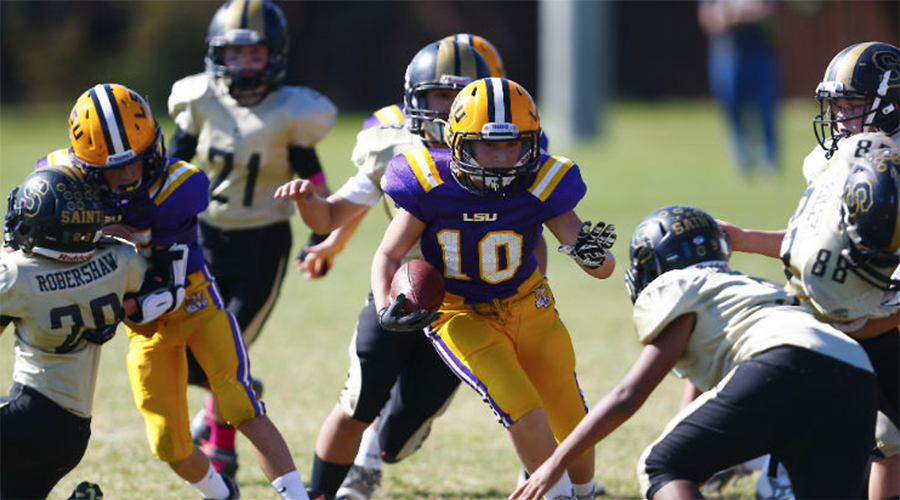USA Football has introduced a phased-approach plan for the return of youth football this year.
“During this very uncertain time, it’s important that parents know that USA football has a detailed plan for getting their children back to the activities they enjoy. This document provides expert guidance in safely returning young athletes to football in a thoughtful and deliberate manner,” said Dr. Michael Koester, Sports Medicine Advisory Committee Chair at the National Federation Of State High School Associations on a USA Football’s “Return To Football 2020” microsite.
USA Football offered four phases guiding football’s return in its guide to coaches to the restart:
Phase 1: Football Workouts And Drills
- Maintain at least six-foot distance between all players and coaches;
- Limit practice to 10 people or less, whether inside or outside, and keep players in groups of five to 10. Players are to only practice together within their small group;
- Focus on football movements and overall athleticism, running drills unopposed to contact; and
- Equipment is not yet shared between players, this includes but is not limited to, football flag belts, tackling dummies, donuts, sleds, and other equipment.
Phase 2: Modified Practices
- Maintain at least a six-foot distance between all players and coaches;
- Practice with up to 10 people inside and 50 people outdoors and keep players within the same group of 5-10 teammates by using station-based activities;
- Run individual drills that are either unopposed without contact or against bags or soft surfaces with coaches remaining six feet from players. Sanitize bags and sleds between each use; and
- Passing, kicking, punting and shotgun snaps between players are acceptable, however, hand-offs and snaps under center are not due to lack of physical distancing; and
- All equipment, including footballs, should be sanitized as frequently as possible during practice.
Phase 3: Modified Flag And 7-On-7 Games; Modified Tackle Practices
- Maintain a three-to-six-foot distance between all players and coaches when not directly participating in practices and games;
- Up to 50 people indoors or outdoors;
- Continue to encourage the use of drills at the “Air” and “Bags” levels of contact. Bags and sleds are to be sanitized between each use;
- Introduce contact, including blocking and tackling, with partners or within small groups. This may include limited 1-on-1 contact drills and 7-on-7 skeleton drills;
- Large group drills like 7 versus 7 skeleton and 11 versus 11 teams must remain non-contact;
- Encourage small-sided type games and activities such as 3-on-3 or 4-on-4 situations (i.e. “2 versus 1 – Read the Defender,” “4-To-Score (3 versus 3)” “Ultimate Football.’); and
- In contact drills, continue to keep players within the same small group of 5-to-10 teammates.
Phase 3: Return To Regular Activities:
Consider returning to regular practice and games without a vaccine/cure once:
- The local area has no restrictions on the size of group gatherings (this does not apply to mass gathering restrictions); and
- Public health authorities allow public facilities to reopen. Under such circumstances, regular practices and games might be appropriate to resume if participants satisfactorily pass relevant pre-activity screening procedures and all live in the same community.
USA Football said it followed guidelines provided by the CDC and worked with the U.S. Olympic and Paralympic Committee (USOPC) and the National Federation of State High School Associations in developing the plan. Subject matter experts from the USOPC, the NCAA, and Pop Warner Little Scholars. The Universities of Minnesota and North Carolina were also involved.
“We have spent a lot of time talking to governing bodies and, for the most part, they are taking this conservative kind of approach,” Scott Hallenbeck, USA Football’s executive director, told the Associate Press. “We’ve recognized the need to have direct conversations, ‘town halls’ as we call them, with a diverse set of constituents. Commissioners from leagues from different socioeconomic levels, and basically surveying of coaches, administrators and parents to help shape phases 1, 2, 3, and beyond.
Hallenbeck added, “We took the approach that there are a lot of variables and this is an incredibly fluid situation. How do we make sure we can consolidate the information and make this flow of information as digestible and simple to understand? And how to take that critical information and turn it into user-friendly resources. It’s been a multi-pronged effort.”
Photo courtesy USA Football














